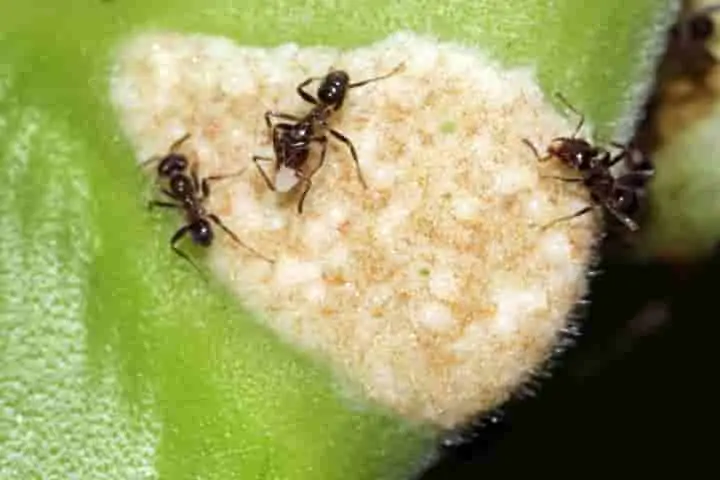

The Azteca ants share a novel relationship with their host Cecropia tree as they protect it from herbivores and repair damage caused to it by other creatures
<p>
<strong>Discoveries are sometimes made in very unusual ways like Isaac Newton finding about gravity on seeing the apple drop from the tree.</strong></p>
<p>
Now recently, as per an article in smithsonianmag.com, during the early days of Covid-19 pandemic in Panama, a boy who with his slingshot and a clay ball made entry and exit holes in a Cecropia tree trunk found out something intriguing. To the teenager&rsquo;s amazement, the Azteca alfari ants residing in the Cecropia trunk had repaired the holes created by his slingshot in their host.</p>
<p>
Cecropia or the &ldquo;ant-plant&rdquo; trees are known for their collaboration with the ferocious Azteca ants. The former helps the latter by providing shelter and food, while the latter protects its leaves vociferously from the herbivores.</p>
<p>
<iframe allow="accelerometer; autoplay; clipboard-write; encrypted-media; gyroscope; picture-in-picture" allowfullscreen="" frameborder="0" height="315" src="https://www.youtube.com/embed/KiAEzfF2y0M" title="YouTube video player" width="560"></iframe></p>
<p>
On seeing this patch up work done on the tree by the ants, five inquisitive high school students became a part of the Smithsonian Tropical Research Institute&rsquo;s (STRI) volunteer programme.</p>
<p>
With the help of William T. Wcislo, a STRI scientist, they devised an experiment. During the first pandemic wave, the friends went around their neighbourhood making holes in the Cecropia trees and noting down the response of the ants to the damage done.</p>
<p>
During their experimentation, the youngsters discovered that the moment holes were made in the trees, the ants would rush into the damaged site and start patching it up. Within two-and-a-half hours the damage was contained to some extent while in 24 hours it was completely renovated.</p>
<p>
<strong>Also read:&nbsp;<a href="https://www.indianarrative.com/science-news/extinction-of-dragonflies-likely-as-wetland-habitats-disappear-137310.html">Extinction of dragonflies likely as wetland habitats disappear</a></strong></p>
<div>
<p>
While it was known earlier too that the Azteca ants defend the Cecropia trees against herbivores the new findings brought to light that these creatures not only try to reduce the damage to trees but also when their host is damaged, they work fast and furiously to control it, more so when their brood is threatened directly.</p>
<p>
The findings of the study appeared in the Journal of Hymenoptera Research.</p>
<p>
Talking about the results, Wcislo observed: <a href="https://www.smithsonianmag.com/blogs/smithsonian-tropical-research-institute/2022/01/03/accidental-tree-wound-reveals-novel-symbiotic-behavior/?utm_source=smithsoniandaily&amp;utm_medium=email&amp;utm_campaign=20220104-daily-responsive&amp;spMailingID=46199309&amp;spUserID=MTI4MDgxMTczNjcwMgS2&amp;spJobID=2160417124&amp;spReportId=MjE2MDQxNzEyNAS2" rel="nofollow">&ldquo;I was totally surprised by the</a> results. And I was impressed by how they developed a simple way to test the idea that ants repair damage to their home.&rdquo;</p>
<p>
Cecropia trees are visited by silky anteaters and sloths regularly and many times their sharp toenails make holes in the wood. These incidents which are common and ancient, scientists feel probably made the Azteca alfari ants evolve into repairer of damage when the plant is harmed, making it a part and parcel of their behaviour.</p>
</div>
<p>
<strong>Also read: <a href="https://www.indianarrative.com/science-news/did-extinction-of-giant-herbivorous-like-woolly-mammoth-and-giant-bison-lead-to-increase-in-wildfires-131628.html">Did extinction of giant herbivorous like woolly mammoth and giant bison lead to increase in wildfires?</a></strong></p>
<p>
The experiment done by the youngster also brought up fresh issues and questions as it was found that not all the ant colonies undertook damage control for the host plants. Trying to figure out and comprehend as to what makes the ants do this, is what will be the subject for future research.</p>
<p>
The study&rsquo;s lead author Alex Wcislo summing up the research said: &ldquo;Sometimes messing around with a slingshot has a good outcome. This project allowed us to experience first-hand all the intricacies behind a scientific study. All in all, it was a great learning experience, especially considering the difficulties associated with fulfilling this due to COVID-19.&rdquo;</p>
The Indo-French Joint Military Exercise SHAKTI-VIII continues to strengthen operational interoperability and mutual cooperation between…
Prime Minister Narendra Modi attended the centenary celebrations of the revered Jain spiritual leader Acharya…
Prominent human rights activist Manzill Murshid anticipated that the upcoming election in Bangladesh will bring…
Iranian Foreign Minister, Seyed Abbas Araghchi, said on Saturday that President Donald Trump should put…
The national capital is hosting ten representatives from the American state of Montana, who are…
An earthquake of magnitude 6.0 struck the Philippines in the early hours of Saturday, as…